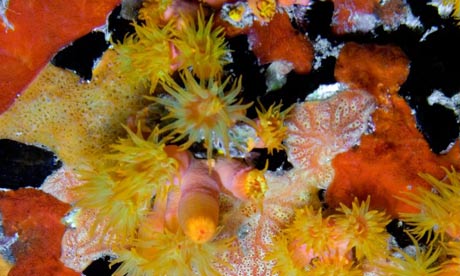On the topic of Great Barrier Reef flood waters posted last week, a rapid response team from my lab, headed by Dr Guillermo Diaz-Pullido and backed by the remote sensing capabilities of Dr Scarla Weeks was busy conducting coral and algal surveys in the Keppels region to determine baselines of coral health before the flood waters hit the reef. Dr Diaz-Pullido and two volunteers (Pim Bongaerts and Norbert Englebert) joined researchers from JCU to determine levels of coral and algae at reefs across the region. Flying out from Rockhampton over the ever rising flood waters confirmed the MODIS satellite images (see bottom left), and shows the level of water damage to the region (see centre): the waters were clearly heading outwards of the reef forming a freshwater lens (see bottom right picture).
 |
 |
 |
| Satellite image showing the Fitzroy river (Jan 21st 2008) |
View of the Fitzroy River in full flood (22nd Jan 2008) |
Flood plume extending out to the inshore reefs (22nd Jan 2008) |
As a bit of background to this region: the Fitzroy catchment at nearly 150,000km2 is the largest of the Great Barier Reef, and is dominated by agriculture (grazing, irrigated cotton and horticulture) and by mining (coal production of 100 million tonnes/year, magnesite and nickel), and significant flooding events have been recorded in 1918, 1954, 1978, 1983, 1988 and 1991 (see below from the Bureau of Meterology). The ABC News site has some astounding images from the 2008 flood here.
 Following the high levels of rainfall in January this year, many have predicted significant flooding and impacts to the inshore coral reefs of the Keppel region. Such disturbances are far from unusual in the Keppels – in 1991, over 85% of coral in shallow reefs died following severe flood events, and again on November 2006, significant mortality occured within 8 hours on the reef flats in the Keppels due to a lethal combination of high rainfall and low tides.
Following the high levels of rainfall in January this year, many have predicted significant flooding and impacts to the inshore coral reefs of the Keppel region. Such disturbances are far from unusual in the Keppels – in 1991, over 85% of coral in shallow reefs died following severe flood events, and again on November 2006, significant mortality occured within 8 hours on the reef flats in the Keppels due to a lethal combination of high rainfall and low tides.
The team surveyed shallow and deep reefs of five islands using belt transects, including more than 300 1×1 m photo quadrats. At the time of the surveys, the freshwater plume from the Fitzroy River had already reached the leeward side of some islands, although at the time of surveying Dr Diaz-Pullido reported no visible impacts on the coral reef benthic community. Benthic macroalgae (seaweeds) usually colonise weakened and dead corals, and during the last coral beaching event in 2006, seaweeds experienced an unprecedented macroalgal bloom. Despite the severity of these disturbances and algal blooms, many coral reefs of the area have recovered and currently flourish (see images below)
 |
 |
 |
| Dr Guillermo Diaz Pullido surveying coral and algal cover prior to the flooding |
Research assistants Pim Bongaerts and Norbert Englebert collect algal samples |
Healthy inshore reefs at the Keppels with high coral cover (Acropora sp. |
The impacts on the reef communities will depend on the residence time of the freshwater plume on the area, the nature and quantity of the sediments and contaminant associated. The team are closely monitoring the oceanographic and meteorological patterns, and depending on the developments of the plume, the research team will head back to the Keppel Islands in the coming weeks. The offshore surface flow in the region is strongly influenced by wind direction, whilst surface flow is primarily offshore (cross-shelf) limited in offshore extent by the frontal boundary created by inflow of oceanic waters due to eddy dynamics further south. Therefore, the Fitzroy outflow will be deflected to the left due to geostrophy (due to rotation of the Earth ) moving along this front.










 Brisbane Times
Brisbane Times






